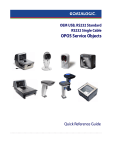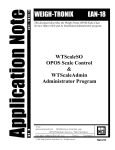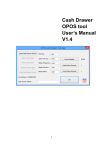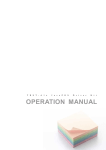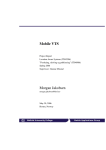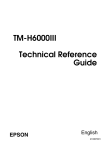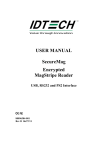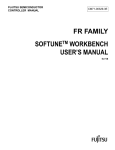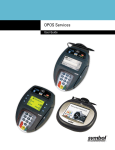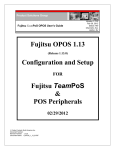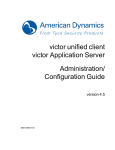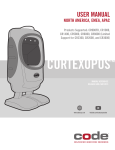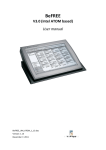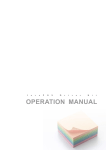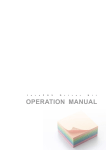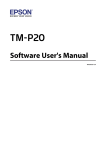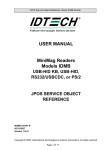Download View - ID TECH JAPAN
Transcript
USER MANUAL
SecuRED
Encrypted Magstripe Reader
OPOS Reference Guide
80128503-001
Rev A. 9/9/13
ID Technologies, Inc.
10721 Walker Street, Cypress CA 90630 Voice: (714) 761-6368 Fax: (714) 761-8880
SecuRED OPOS User Manual
Revision History
Revision
Date
Description
By
A
9/9/2013
Initial Release
CH
2
SecuRED OPOS User Manual
Table of Contents
1.
2.
2.1.
2.2.
2.3.
3.
3.1.
3.2.
3.3.
4.
Description ................................................................................................................................ 6
Methods, Properties and Events of SecuRED ........................................................................... 7
Methods of MSR .................................................................................................................. 7
Properties of MSR .............................................................................................................. 11
Events of MSR ................................................................................................................... 22
Programming Examples .......................................................................................................... 24
Visual C++ 6.0 Programming Example .............................................................................. 24
Visual Basic 6.0 Programming Example ............................................................................ 26
Visual Studio 2005/2008 C# Programming Example ......................................................... 29
Result Code/Error Code List ................................................................................................... 32
3
SecuRED OPOS User Manual
ID TECH SOFTWARE COPYRIGHT NOTICE
Copyright 2010-2013 International Technologies & Systems Corporation. All rights
reserved. ID TECH is a registered trademark of International Technologies & Systems
Corporation. Value through Innovation, Spectrum is trademarks of International
Technologies & Systems Corporation.
ID TECH SOFTWARE LICENSE AGREEMENT
ID TECH ("LICENSOR") IS WILLING TO LICENSE THIS SOFTWARE TO YOU
ONLY IF YOU ACCEPT ALL OF THE TERMS IN THIS LICENSE AGREEMENT.
PLEASE READ THE TERMS CAREFULLY BEFORE YOU AGREE BECAUSE
YOU WILL BE BOUND BY THE TERMS OF THIS AGREEMENT. IF YOU DO
NOT AGREE TO THESE TERMS, LICENSOR WILL NOT LICENSE THIS
SOFTWARE TO YOU.
Ownership of the Software
1. The Licensor software program ("Software") and any accompanying written
materials are owned by Licensor [or its suppliers] and are protected by United States
copyright laws, by laws of other nations, and by international treaties.
Grant of License
2. Licensor grants to you the right to use the Software in conjunction with an ID
TECH product. You may load one copy into permanent memory of one computer and
may use that copy only on that same computer.
Restrictions on Use and Transfer
3. You may not copy the Software, except that (1) you may make one copy of the
Software solely for backup or archival purposes, and (2) you may transfer the
Software to a single hard disk provided you keep the original solely for backup or
archival purposes. You may not copy the written materials.
4. You may permanently transfer the Software and any accompanying written
materials (including the most recent update and all prior versions) if you retain no
copies and the transferee agrees to be bound by the terms of this Agreement. Such a
transfer terminates your license. You may not rent or lease the Software or otherwise
transfer or assign the right to use the Software, except as stated in this paragraph.
5. You may not reverse engineer, decompile, or disassemble the Software.
4
SecuRED OPOS User Manual
Limited Warranty
6. If used in conjunction with an ID TECH product, Licensor warrants that the
Software will perform substantially in accordance with the accompanying written
materials for a period of 90 days from the date of your receipt of the Software. Any
implied warranties on the Software are limited to 90 days. Some states and territories
do not allow limitations on duration of an implied warranty, so the above limitation
may not apply to you.
7. LICENSOR DISCLAIMS ALL OTHER WARRANTIES, EITHER EXPRESS
OR IMPLIED, INCLUDING BUT NOT LIMITED TO IMPLIED WARRANTIES
OF MERCHANTABILITY, FITNESS FOR A PARTICULAR PURPOSE, AND
NON-INFRINGEMENT, WITH RESPECT TO THE SOFTWARE AND ANY
ACCOMPANYING WRITTEN MATERIALS. This limited warranty gives you
specific legal rights. You may have others, which vary from state to state.
8. LICENSOR'S ENTIRE LIABILITY AND YOUR EXCLUSIVE REMEDY
SHALL BE REPLACEMENT OF THE SOFTWARE THAT DOES NOT MEET
LICENSOR'S LIMITED WARRANTY. Any replacement Software will be warranted
for the remainder of the original warranty period or 30 days, whichever is longer.
9. This Limited Warranty is void if failure of the Software has resulted from
modification, accident, abuse, or misapplication.
10. IN NO EVENT WILL LICENSOR BE LIABLE TO YOU FOR DAMAGES,
INCLUDING ANY LOSS OF PROFITS, LOST SAVINGS, OR OTHER
INCIDENTAL OR CONSEQUENTIAL DAMAGES ARISING OUT OF YOUR USE
OR INABILITY TO USE THE SOFTWARE. Because some states do not allow the
exclusion or limitation of liability for consequential or incidental damages, the above
limitation may not apply to you.
11. This Agreement is governed by the laws of the state of California.
12. If you have any questions concerning this Agreement or wish to contact Licensor
for any reason, please write: ID TECH, 10721 Walker Street, Cypress, CA 90630 or
call (714) 761-6368.
13. U.S. Government Restricted Rights. The Software and documentation are
provided with Restricted Rights. Use, duplication, or disclosure by the Government is
subject to restrictions set forth in subparagraph (c)(1) of The Rights in Technical Data
and Computer Software clause at DFARS 252.227-7013 or subparagraphs (c)(1)(ii)
and (2) of Commercial Computer Software - Restricted Rights at 48 CFR 52.227-19,
as applicable. Supplier is ID TECH, 10721 Walker Street, Cypress, CA 90630.
5
SecuRED OPOS User Manual
1. Description
The documentation describes the properties, methods, and events of the ID TECH
SecuRED MSR OPOS component. The component includes two parts: a Control
Object running on the upper level, which is an ActiveX control, and a Service Control
running on the lower level, which is an OLE automation server. The properties,
methods, and events are exposed by the Control Object. When the Control Object is
imported into your project as an ActiveX control, you will see all the properties,
methods, and events.
For different interface devices, OPOS drivers may be different. For USB HID
Keyboard interfaces device, the standard keyboard should not be pressed when
swiping cards, otherwise the card data will be wrong , MSR OPOS Driver will display
a warning dialog and the data will be discarded.
The SecuRED MSR device can’t support hot plug when OPOS driver is in the Open
state. If you have already pulled out the device in Open state, close driver and reopen
can use again.
For the same interface SecuRED MSR devices, the OPOS supports only one device
for use on a computer. In other words: at the same time, the OPOS only allows to
connect one device.
If the SecuRED MSR Device has been authenticated, the application should cancel
the authentication before close the OPOS. Otherwise, the device will stay in the
authentication state 120 seconds.
Target Device:
ID TECH SecuRED
USB-HID, USB-KB interface
Platform:
Microsoft Windows 8,Windows 7,Vista, XP, 2000, 98.
Service Object and Control Object:
Service Object Version: 1.13.309
Control Object Version: 1.13.001
Dll File Version: 3.0.9
6
SecuRED OPOS User Manual
2. Methods, Properties and Events of SecuRED
This section describes methods, properties and events for the SecuRED Encrypted
MSR.
2.1. Methods of MSR
These function declarations may be different when the Control Object
(OPOSMSR.OCX) is imported into your application project. Please refer to the
UnifiedPOS Specification for more detailed information on the Control Object.
1) Open
Syntax
LONG Open (BSTR DeviceName);
DeviceName:
For USB HID interface: “IDTECH_ SECURED _USBHID”
For USB KB interface: “IDTECH_ SECURED _USBKB”
Remarks Call to open a device for subsequent I/O.
Support? Yes
Description This method finds more parameters in the Windows Register Tables on
key or sub keys.
For USB HID interface:
HKEY_LOCAL_MACHINE\Software\OLEforRetail\ServiceOPOS\MSR\
IDTECH_ SECURED _USBHID\ CONNECTOR
Key value name: USBHID
Key value: "usbhidConn.dll"
Key value name: CONNECTOR
Key value: "USBHID/0acd/2810"
First field USBHID specify the type of the connector. 0acd is the USB device
vendor ID, 2810 is the reader product ID.
For USB KB interface:
HKEY_LOCAL_MACHINE\Software\OLEforRetail\ServiceOPOS\MSR\
IDTECH_ SECURED _USBKB\ CONNECTOR
Key value name: USBKB
Key value: "usbkbConnector.dll"
Key value name: CONNECTOR
Key value: "USBKB/0acd/2820"
First field USBKB specify the type of the connector. 0acd is the USB device
vendor ID, 2820 is the reader product ID.
2) ClaimDevice
Added in Release 1.5
Syntax
LONG ClaimDevice (LONG Timeout);
7
SecuRED OPOS User Manual
Remarks Call this method to request exclusive access to the device. Many devices
require an application to claim them before they can be used. Release 1.0 – 1.4 in
releases prior to 1.5, this method is named Claim.
Support? Yes
3) CheckHealth
Syntax
LONG CheckHealth (LONG Level);
Remarks Called to test the state of a device.
Support? Yes
Description When select CH_INTERNAL, check the SO response, if not it tells that
there is something wrong with the device. CheckHealthText property will be “Internal
HCheck: Successful”
When select CH_EXTERNAL, SO will return the firmware version of the
SecuRED device, if reading the firmware version is successful. CheckHealthText
property will be “External HCheck: Successful” + firmware version information. If
Not Responding, CheckHealthText property will be “External HCheck: Not
Responding”.
When select CH_INTERACTIVE , SO will display a dialog, which include
firmware version and swiping card. And it can display the “Real data” of the card;
include Start Sentinel and End Sentinel. CheckHealthText property will show
“External HCheck:: HCheck: Complete”, after the dialog is closed.
4) ClearInput
Syntax
LONG ClearInput ();
Remarks Called to clear all device input that has been buffered.
Support? Yes
5) DirectIO
Syntax
LONG DirectIO (LONG Command, LONG* pData, BSTR* pString);
Remarks
Call to communicate directly with the Service Object.
Support? No
Description In the current, it implemented incompletely. We will improve it in the
next release.
6) ReleaseDevice
Added in Release 1.5
Syntax
LONG ReleaseDevice ();
Remarks Call this method to release exclusive access to the device.
Release 1.0 – 1.4
In releases prior to 1.5, this method is named Release.
Support? Yes
7) Close
Syntax
Remarks
LONG Close ();
Called to release the device and its resources.
8
SecuRED OPOS User Manual
Support?
Yes
8) ResetStatistics Added in Release 1.8
Syntax
LONG ResetStatistics(BSTR m_StatisticsBuffer);
Remarks Called to Resets the defined resettable statistics in a device to zero.
Support? No
9) RetrieveStatistics Added in Release 1.8
Syntax
LONG RetrieveStatistics(BSTR* m_pStatisticsBuffer);
Remarks Called to Retrieves the requested statistics from a device.
Support? No
10) UpdateStatistics Added in Release 1.8
Syntax
LONG UpdateStatistics(BSTR m_StatisticsBuffer);
Remarks Called to Updates the defined resettable statistics in a device.
Support? No
11) CompareFirmwareVersion
Syntax
LONG CompareFirmwareVersion(BSTR m_FirmwareFileName,
long* m_pResult);
Remarks Called to compare the firmware version with current firmware version of
the device.
Support? No
12) UpdateFirmware
Syntax
LONG UpdateFirmware(BSTR m_FirmwareFileName);
Remarks Called to update current firmware.
Support? No
13) ClearInputProperties
Syntax
void ClearInputProperties();
Remarks Sets all data properties that were populated as a result of firing a
DataEvent or ErrorEvent back to their default values.
Support? Yes
14) WriteTracks
Syntax
long WriteTracks(LPCTSTR data, long timeout)
Remarks Sets all data properties that were populated as a result of firing a
DataEvent or ErrorEvent back to their default values.
Support? No
15) AuthenticateDevice
Syntax
long AuthenticateDevice (LPCTSTR response)
Remarks To authenticate a device, the application first calls the
9
SecuRED OPOS User Manual
Support?
retrieveDeviceAuthenticationData method to retrieve a challenge token
from the device. The application then typically passes this token to
another entity that has special knowledge of a shared secret and is able to
create a proper response token. This response token is then passed as the
response parameter to this method and the service uses it to validate the
authentication request. If this method succeeds, the device enters the
authenticated state and the service sets the DeviceAuthenticated property
to true.
For SecuRED: The response needs to be 16 bytes in length. And it
should be transmitted as a Hex string. Example, 0xAB 0x00 0x09 is
converted to "AB0009".
Yes
16) DeauthenticateDevice
Syntax
long DeauthenticateDevice (LPCTSTR response)
Remarks This method is used to deauthenticate a device that is currently in the
authenticated state (DeviceAuthenticated = true). The token is typically
generated by passing the challenge retrieved from the
retrieveDeviceAuthenticationData method to an entity that has special
knowledge of a shared secret. If this method succeeds the service sets
DeviceAuthenticated to false and enqueues a StatusUpdateEvent with
status value set to MSR_SUE_DEVICE_DEAUTHENTICATED.
For SecuRED: The response needs to be 16 bytes (when Encryption
Algorithm is 3DES) or 8 bytes (when Encryption Algorithm is AES) in
length. And it should be transmitted as a Hex string. Example, 0xAB
0x00 0x09 is converted to "AB0009".
Support? Yes
17) RetrieveCardProperty
Syntax
long RetrieveCardProperty (BSTR Name, BSTR *Value)
Remarks Retrieves the value of specific parsed properties from the
last card swiped.
Support? Yes
10
SecuRED OPOS User Manual
18) RetrieveDeviceAuthenticationData
Syntax
long RetrieveDeviceAuthenticationData (LPCTSTR challenge)
Remarks Applications call this method to retrieve a challenge token that will
subsequently be used to generate response tokens that will be passed to
the authenticateDevice and deauthenticateDevice methods. The
challenge token is typically sent to another entity that has special
knowledge of a shared secret that is required to generate the proper
response token(s).
For SecuRED: The challenge is always 26 bytes in length. And it will be
transmitted as a Hex string. Example, 0xAB 0x00 0x09 is converted to
"AB0009".
Support? Yes
19) UpdateKey
Syntax
long UpdateKey (BSTR Key, BSTR KeyName)
Remarks Provides a new encryption key to the device. It is used only for those
encryption algorithms in which new key values are sent to the terminal
as a field in standard messages from the host.
Support? NO
2.2. Properties of MSR
Please refer to the UnifiedPOS Specification for detailed information.
NOTE: CO --- Control Object
SO --- Service Object
AP or App --- the abbreviation of Application.
11
SecuRED OPOS User Manual
Property Group1---Description
Name
Type
Mutability
Use
Description
Support?
Identify the Control Object and
Yes
After
String
DeviceControlDescri
read-only
--
the company that produced it
ption
int32
DeviceControlVersio
read-only
--
Hold the Control Object version
Yes
number.
n
DeviceServiceDescrip
String
read-only
open
Identify the Service Object
Yes
supporting the device and the
tion
company that
produced it
DeviceServiceVersion
int32
read-only
open
Hold the Service Object version
Yes
number.
PhysicalDeviceDescri
string
read-only
open
Yes
pertinent information about it.
ption
PhysicalDeviceName
Identify the device and any
string
read-only
open
Identify the device and any
Yes
pertinent information about it.
Property Group2---Control
Name
Type
Mutability
Use
Description
Support?
SecuRED must be claimed for
Yes
After
Claimed
Boolean
read-only
open
exclusive use before access its
methods and properties, and
before any events to be fired.
It
is initialized to FALSE by the
Open method. It is set to TRUE
after the method Claim is
successfully called.
AutoDisable
Boolean
read-write
open
When TRUE, as soon as an event
Yes
DataEvent is received, then
DeviceEnabled is automatically
to FALSE. It is initialized to
FALSE by the Open method.
DeviceEnabled
Boolean
read-write
open&
When FALSE, SecuRED has
claim
been disabled and any subsequent
input will be discarded (No
DataEvent could be received even
if the card is swiped). It is
initialized to FALSE by the Open
12
Yes
SecuRED OPOS User Manual
method.
FreezeEvents
boolean
read-write
open
When TRUE, events are not
Yes
required to be delivered and will
be held by SO until events are
unfrozen.
It is initialized to
FALSE by the Open method.
DataEventEnabled
boolean
read-write
open
When TRUE, a DataEvent or
Yes
ErrorEvent will be delivered
immediately when had. (Of
course, FreezeEvents=FALSE
and DeviceEnabled=TRUE is a
prerequisite). It is initialized to
FALSE by the Open method.
CapPowerReportin
int32
read-only
open
Identifies the reporting
No
capabilities of the device about
g
Power. It seems that SecuRED
doesn’t support in the hardware.
PowerNotify
int32
read-write
open
Contains the type power
No
notification selection made by the
Application.
is initialized to
OPOS_PN_DISABLED by the
Open method.
PowerState
int32
read-only
open
Contains the current power
condition.
No
It seems that
SecuRED doesn’t support in the
hardware.
State
int32
Read-only
--
Contains the current state of the
Yes
Control. It can be set to one of the
four
Values: Closed, Idle, Busy, or
Error.
DataCount
int32
Read-only
open
Holds the number of queued
Yes
DataEvents remained in the
queue.
CheckHealthText
string
read-only
open
Holds the results of the most
recent call to the CheckHealth
method.
Before the first
CheckHealth method call, its
value is uninitialized.
13
Yes
SecuRED OPOS User Manual
Property Group3---Track Control
Name
Type
Mutability
Use
Description
Support?
If TRUE, SecuRED
Yes
After
CapISO
boolean
read-only
open
supports ISO cards.
CapJISOne
boolean
read-only
open
If TRUE, SecuRED
No
supports JIS Type-I
cards. JIS-I cards are a
superset of ISO cards.
Therefore, if
CapJISOne is true, it is
implied that CapISO is
also TRUE.
CapJISTwo
boolean
read-only
open
If TRUE, SecuRED
No
supports JIS type-II
cards.
CapTransmitSentinels
boolean
read-only
open
If TRUE, SecuRED is
Yes
able to transmit the start
and end sentinels. e.g.
start sentinel could be
‘%’ or ‘;’, and stop
sentinel could be ‘?’.
DecodeData
boolean
read-write
open
If TRUE, each byte of
Yes
track data properties is
mapped from its original
encoded bit sequence (as
it exists on the magnetic
card) to its
corresponding decoded
ASCII bit sequence.
ParseDecodeData
boolean
read-write
open
When TRUE, the
Yes
decoded data contained
within the Track1Data
and Track2Data
properties is further
separated into fields for
access via various other
properties.
If
DecodeData=FALSE,
ParseDecodeData must
be false.
TransmitSentinels
boolean
read-write
14
open
If TRUE, the
Yes
SecuRED OPOS User Manual
Track1Data,
Track2Data,
Track3Data, and
Track4Data properties
contain start and end
sentinel values.
Otherwise only the track
data between these
sentinels.
TracksToRead
int32
read-write
open
Indicate which track
Yes
data that the App wishes
to get following a card
sweep.
ErrorReportingType
int32
Read-write
open
Holds the type of errors
Yes
to report via
ErrorEvents. This
property has one of the
following values:
MSR_ERT_CARD or
MSF_ERT_TRACK
Property Group4---TrackData
Name
Type
Mutability
Use
Description
Support?
Holds the track 1 data
Yes
After
Track1Data
binary
read-only
open
obtained from the most
recently swept card.
If
DecodeData is true, then it
has been decoded from the
“raw” format. it may also be
parsed into other properties
when the ParseDecodeData
property is set.
Track1DiscretionaryD
binary
read-only
open
Holds the track 1
discretionary data obtained
ata
from the most recently swept
card.
It may be NULL
when:
1) The field was not included
in the track data obtained, or,
2) The track data format was
15
Yes
SecuRED OPOS User Manual
not supported, 3)
ParseDecodeData is false.
Track2Data
binary
read-only
open
Holds the track 2 data
Yes
obtained from the most
recently swept card.
If
DecodeData is true, then it
has been decoded from the
“raw” format. it may also be
parsed into other properties
when the ParseDecodeData
property is set.
Track2DiscretionaryD
binary
read-only
open
Holds the track 2
Yes
discretionary data obtained
ata
from the most recently swept
card.
It may be NULL
when:
1) The field was not included
in the track data obtained, or,
2) The track data format was
not supported, 3)
ParseDecodeData is false.
Track3Data
binary
read-only
open
Holds the track 3 data
Yes
obtained from the most
recently swept card.
Track4Data
binary
read-only
open
Holds the track 4 data (JIS-II)
No
obtained from the most
recently swept card.
Track1EncryptedData
binary
read-only
Open
Holds the encrypted track 1
data obtained from the most
recently swiped card. The
start and end sentinel values
are contained in it, and
appear only after data is
decrypted.
Encrypted data is always a
multiple of 8 bytes (when
Encryption Algorithm is
3DES) or 16 bytes (when
Encryption Algorithm is
AES) in length. And it will
be transmitted as a Hex
string. Example, 0xAB 0x00
0x09 is converted to
16
Yes
SecuRED OPOS User Manual
"AB0009".
Track1EncryptedData
int32
read-only
Open
Holds the length of the raw
Yes
track 1 data before it was
Length
encrypted.
Track2EncryptedData
binary
read-only
Open
Holds the encrypted track 2
Yes
data obtained from the most
recently swiped card. The
start and end sentinel values
are contained in it, and
appear only after data is
decrypted.
Encrypted data is always a
multiple of 8 bytes (when
Encryption Algorithm is
3DES) or 16 bytes (when
Encryption Algorithm is
AES) in length. And it will
be transmitted as a Hex
string. Example, 0xAB 0x00
0x09 is converted to
"AB0009".
Track2EncryptedData
int32
read-only
Open
Holds the length of the raw
Yes
track 2 data before it was
Length
encrypted.
Track3EncryptedData
binary
read-only
Open
Holds the encrypted track 3
Yes
data obtained from the most
recently swiped card. The
start and end sentinel values
are contained in it, and
appear only after data is
decrypted.
Encrypted data is always a
multiple of 8 bytes (when
Encryption Algorithm is
3DES) or 16 bytes (when
Encryption Algorithm is
AES) in length. And it will
be transmitted as a Hex
string. Example, 0xAB 0x00
0x09 is converted to
"AB0009".
Track3EncryptedData
int32
read-only
Open
Holds the length of the raw
track 3 data before it was
Length
17
Yes
SecuRED OPOS User Manual
encrypted.
Track4EncryptedData
binary
read-only
Open
Holds the encrypted track 4
No
data obtained from the most
recently swiped card.
Track4EncryptedData
binary
read-only
Open
Holds the length of the raw
No
track 4 data before it was
Length
encrypted.
AdditionalSecurityInf
binary
read-only
Open
Holds additional
Yes
security/encryption
ormation
information when a
DataEvent is delivered. For
example “DUKPT sequence
number” in it.
This data is always 10 bytes
in length. And it will be
transmitted as a Hex string.
Example, 0xAB 0x00 0x09 is
converted to "AB0009".
CardAuthenticationD
binary
read-only
Open
Holds card authentication
No
information when a
ata
DataEvent is delivered.
CardAuthenticationD
int32
read-only
Open
This property will be zero if
No
CapCardAuthentication is an
ataLength
empty string.
DeviceAuthenticated
boolean
read-only
Open
If the device supports
&
authentication the service
Claim
must keep the value of this
&
property up to date when the
Enabl
device is enabled.
e
MSR_SUE_DEVICE_AUTH
Yes
ENTICATED or
MSR_SUE_DEVICE_DEAU
THENTICATED.
CardType
string
read-only
open
Holds the card type identifier
Yes
for the most recently swiped
card. Value is one of them
(“BANK”,”AAMVA” and
empty).
CardTypeList
string
read-only
open
Holds a comma separated list
of string names of card types
supported by the Service.
Value is BANK and
AAMVA.
18
Yes
SecuRED OPOS User Manual
CardPropertyList
string
read-only
open
Holds a comma separated list
Yes
of the names of the properties
parsed from the most recently
swiped card.
Property Group5---ParsedData
Name
Type
Mutability
Use
Description
Support?
Holds the account number
Yes
After
AccountNumber
string
read-only
Open
obtained from the most
recently swept card.
it is initialized to NULL if:
1) The field was not included
in the track data obtained, or,
2) The track data format was
not supported, or, 3)
ParseDecodeData is false.
ExpirationData
string
read-only
Open
Holds the expiration date
Yes
obtained from the most
recently swept card.
Others
are same as AccountNumber.
FirstName
string
read-only
Open
Holds the first name obtained
Yes
from the most recently swept
card.
Others are same as
AccountNumber.
MiddleInitial
string
read-only
Open
Holds the middle initial
Yes
obtained from the most
recently swept card.
Others
are same as AccountNumber.
Surname
string
read-only
Open
Holds the surname obtained
Yes
from the most recently swept
card.
Others are same as
AccountNumber.
Title
string
read-only
Open
Holds the title obtained from
Yes
the most recently swept card..
Others are same as
AccountNumber.
Suffix
string
read-only
Open
Holds the suffix obtained from
the most recently swept card..
Others are same as
AccountNumber.
19
Yes
SecuRED OPOS User Manual
ServiceCode
string
read-only
Open
Holds the service code
Yes
obtained from the most
recently swept card.
Others
are same as AccountNumber.
Property Group6--- Statistic
Name
Type
Mutability
Use
Expected Result
After
CapStatisticsReporting
boolean
read-write
Open
Test
Result
If true ,the SO can get device
No
information to a XML statistics
CapUpdateStatistics
boolean
read-write
Open
If true ,the SO can update the
No
XML statistics
Property Group7---Firmware
Name
Type
Mutability
Use
Expected Result
After
CapCompareFirmware
boolean
read-write
Open
Result
If true ,the SO can compare the
No
Firmware version
Version
CapUpdateFirmware
Test
boolean
read-write
Open
If true ,the SO can update the
No
firmware of the device
CapWritableTracks
Int32
read_only
Open
This capability indicates if the
No
SecuRED device supports the
writing of track data - and
which tracks are supported.
EncodingMaxLength
Int32
read_only
Open
The maximum length of data
No
that can be written by the
SecuRED to the track(s).
TracksToWrite
Int32
Read-Write
Open
Holds the SecuRED track(s)
No
that will be written.
CapDataEncryption
Int32
read_only
Open
Holds a bitwise indication of
the encryption algorithms
supported by the device and
selectable via the
20
Yes
SecuRED OPOS User Manual
DataEncryptionAlgorithm
property. MSR_DE_NONE:
Data encryption is not enabled.
MSR_DE_3DEA_DUKPT:
Triple DES Derived Unique
Key Per Transaction.
MSR_DE_AES_DUKPT
(value:3): Advanced
Encryption Standard Derived
Unique Key Per Transaction.
DataEncryptionAlgorit
Int32
Read-Write
hm
Open
Holds the encryption algorithm
&
that will be used to encrypt the
Claim
track data. This property may
Yes
be set to one of the supported
encryption algorithms as
defined in the
CapDataEncryption property.
MSR_DE_NONE: Data
encryption is not enabled.
CapTrackDataMaskin
boolean
Read_only
Open
This value will be true if the
Yes
Service is capable of masking
g
track data.
CapCardAuthenticatio
string
Read_only
Open
Holds the type, if any, of card
No
authentication data that is
n
supported by the device.
CapDeviceAuthenticati
Int32
Read_only
Open
Holds the level of device
Yes
authentication supported by the
on
service.
MSR_DA_NOT_SUPPORTE
D: The service does not support
device authentication.
MSR_DA_OPTIONAL: The
service supports device
authentication but does not
require it.
MSR_DA_REQUIRED: The
service requires device
authentication.
DeviceAuthenticationP
Int32
Read_only
Open
Holds the device authentication
protocol supported by the
rotocol
device. MSR_AP_NONE: The
service does not support device
21
Yes
SecuRED OPOS User Manual
authentication.
MSR_AP_CHALLENGERESP
ONSE: The service supports
the challenge response
protocol.
WriteCardType
string
Read-Write
Open
Holds the card type to be used
No
the next time the write Tracks
method is called.
2.3. Events of MSR
These events are fired by the Service Object when it is necessary. The following functions are, in
fact, the event-handlers that can be added into the applications. Then the applications can receive
these events and do some processing accordingly. Please refer to the UnifiedPOS Specification for
detailed information.
1) DataEvent
Syntax
void DataEvent (LONG Status);
The Status parameter contains the input status. Its value is Control-dependent.
And it may describe the type or qualities of the input.
Remarks
Fired to present input data from the device to the application.
Description a DataEvent can be received when a magnetic card is swiped if the three
conditions are all met:
1) DeviceEnabled = TRUE
2) FreezeEvents = FALSE
3) DataEventEnabled = TRUE.
The track data can be obtained, and the parsed data can also be obtained if ParseDecodeData is
TRUE.
Support?
Yes
2) DirectIO Event
void DirectIOEvent (LONG EventNumber, LONG* pData, BSTR* pString);
Parameter Description
EventNumber Event number. Specific values are assigned by the
Service Object.
pData
Pointer to additional numeric data. Specific values vary
by EventNumber and the Service Object.
pString
Pointer to additional string data. Specific values vary by
EventNumber and the Service Object.
Remarks
Fired by a Service Object to communicate directly with the application.
Description The event DirectIOEvent is used for some special communication between one
SO and an application. Currently, this event is not fully implemented.
Support?
No
Syntax
3) Error Event
22
SecuRED OPOS User Manual
void ErrorEvent (LONG ResultCode, LONG ResultCodeExtended,
LONG ErrorLocus, LONG* pErrorResponse);
Parameter Description
ResultCode
Result code causing the error event. See ResultCode for
values.
ResultCodeExtended Extended result code causing the error event. See
ResultCodeExtended for values.
ErrorLocus
Location of the error. See values below.
PErrorResponse
Pointer to the error event response. See values below.
When ErrorReportingType property is MSR_ERT_TRACK, and ErrorCode is E_EXTENDED,
then ErrorCodeExtended contains Track-level status, broken down as follows:
Syntax
Byte3
Byte2
Byte1
Byte0
Track 4
Track 3
Track 2
Track 1
Remarks Fired when an error is detected and the Control’s State transitions into the error state.
NOTICE: The error type is only one E_FAILURE (Other or general error) while any error is
raised from reading card of SecuRED device. Because the SecuRED hardware cannot support
discerning wrong type.
Support?
Yes
4) StatusUpdate Event
Syntax
void StatusUpdateEvent (LONG Status);
The Status parameter is for device class-specific data, describing the type of status change.
Remarks
Fired when a Control needs to alert the application of a device status change.
Note
The SecuRED hardware cannot support the notification of power status change.
Description It is not implemented by the SO for the power status cannot be inquired from the
SecuRED.
Support?
No
23
SecuRED OPOS User Manual
3. Programming Examples
There are three simple programming simple examples provided in this section
including VC++6.0, VB6.0, and VS2005/2008 C#. The examples include basic
operations and event handling.
In general, there are two steps to work with the OPOS control object:
1. Insert the OPOS Control Object (CO) into the project
2. Add an event handle
3.1. Visual C++ 6.0 Programming Example
Programming Environment:
Windows XP Pro, Visual C++ 6.0, OPOS CO 1.13. ID TECH SO 1.13.307
1. Download the OPOS driver and demo from the IDTECH website
www.idtechproducts.com. Install the driver and make sure the OPOS demo is
functioning.
2. In Visual C++ 6.0, create a Dialog Based MFC application using MFC
Application Wizard with ActiveX supports.
3. Go to Project Add to Project Components and Controls. From the
“Registered ActiveX Controls” folder, select “OPOS MSR Control 1.13.001”, and
insert this ActiveX control into the project. An icon for OPOS MSR will be added
to the Controls toolbar.
4. Add the OPOS MSR CO to the project dialog.
24
SecuRED OPOS User Manual
5. Add DataEvent and ErrorEvent handle
void CMfc_diagDlg::OnDataEventMsr1(long Status)
6. Go the View->ClassWizard and select the “Member Variables” tab. Select
IDC_MSR and add a member variable of type “COPOSMSR”, name it m_msr.
7. Create a button on the form and add the following initialization code:
void CMfc_diagDlg::OnButton1()
{
if (m_msr.Open("IDTECH_SecuRED_USBKB") == 0)
{
m_msr.ClaimDevice(100);
m_msr.SetDeviceEnabled(TRUE);
m_msr.SetDataEventEnabled(TRUE);
25
SecuRED OPOS User Manual
}
else {
// something wrong ...
}
}
8. Add code for DataEvent handle
void CMfc_diagDlg::OnDataEventMsr1(long Status)
{
MessageBox(m_msr.GetTrack1Data(), "Track 1 data");
m_msr.SetDataEventEnabled(TRUE); // prepare the next event.
}
9. Compile and run the program. Compile and run the program. Click on “Button1”
to initialize the reader and swipe a card. Track 1 data will show up in a message
box.
3.2. Visual Basic 6.0 Programming Example
Programming Environment:
Windows XP Professional, Visual Basic 6.0, OPOS CO 1.13. ID TECH SO 1.13.307
1. Create a new project of type “Standard EXE”.
2. From Project->Components, select “OPOS MSR Control 1.13.001” and click
“apply”. The OPOS MSR icon will be added to the control toolbar.
26
SecuRED OPOS User Manual
3. Add an OPOS MSR control to the form. Double click on the control to add
“DataEvent” handle.
4. Add the initialization code:
Private Sub Form_Load()
OPOSMSR1.Open("IDTECH_SecuRED_USBKB")
OPOSMSR1.ClaimDevice (100)
OPOSMSR1.DeviceEnabled = True
OPOSMSR1.DataEventEnabled = True
End Sub
5. Add the code for Event Handle
27
SecuRED OPOS User Manual
Private Sub OPOSMSR1_DataEvent(ByVal Status As Long)
MsgBox OPOSMSR1.Track1Data
OPOSMSR1.DataEventEnabled = True
End Sub
6. Run program and swipe a card. The track 1 data will show up in a message box.
28
SecuRED OPOS User Manual
3.3. Visual Studio 2005/2008 C# Programming Example
Programming Environment:
Windows XP Professional, Visual Studio 2005/2008 C#, OPOS CO 1.13.001 ID
TECH SO 1.13.307
1. Create a “Windows Application” Project.
2. Right click on the “Toolbox” tool bar, select “Choose item …”. Under “COM
Components” tab, select “OPOS MSR Control 1.13.001” and click okay.
3. Add “OPOS MSR Control” to “Form1”. Double click on the OPOS MSR Control
to add DataEvent handler code. Notice that the device name might need to be changed
for different interface.
29
SecuRED OPOS User Manual
private void Form1_Load(object sender, EventArgs e)
{
if (axOPOSMSR1.Open("IDTECH_SecuRED_USBKB") == 0)
//0 is OPOS_SUCCESS
{
axOPOSMSR1.ClaimDevice(100);
axOPOSMSR1.DeviceEnabled = true;
axOPOSMSR1.DataEventEnabled = true;
}
}
private void axOPOSMSR1_DataEvent(object sender,
AxOposMSR_1_13_Lib._IOPOSMSREvents_DataEventEvent e)
{
MessageBox.Show(axOPOSMSR1.Track1Data, "Track 1 data");
axOPOSMSR1.DataEventEnabled = true;
}
4. Run the program and swipe a card. Track 1 data will be displayed in a window.
30
SecuRED OPOS User Manual
31
SecuRED OPOS User Manual
4. Result Code/Error Code List
const
const
const
const
const
const
const
const
const
const
const
const
const
const
const
LONG
LONG
LONG
LONG
LONG
LONG
LONG
LONG
LONG
LONG
LONG
LONG
LONG
LONG
LONG
OPOS_SUCCESS
OPOS_E_CLOSED
OPOS_E_CLAIMED
OPOS_E_NOTCLAIMED
OPOS_E_NOSERVICE
OPOS_E_DISABLED
OPOS_E_ILLEGAL
OPOS_E_NOHARDWARE
OPOS_E_OFFLINE
OPOS_E_NOEXIST
OPOS_E_EXISTS
OPOS_E_FAILURE
OPOS_E_TIMEOUT
OPOS_E_BUSY
OPOS_E_EXTENDED
=
=
=
=
=
=
=
=
=
=
=
=
=
=
=
32
0;
101;
102;
103;
104;
105;
106;
107;
108;
109;
110;
111;
112;
113;
114;


































